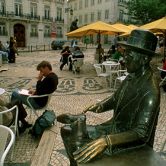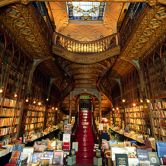Writers’ Houses
As you discover Portugal, the houses of writers can give you a different outlook on the places you visit.
We like to think that writers are special people, inspired by the places where they live. The houses give us more information on how they lived, where they wrote and how they worked, and many times we are surprised at the simplicity of those houses, located in idyllic settings, as if the landscape were enough to feed the creative genius. Visit these houses and learn a little more about the Portuguese soul.

Vale do Douro ©José Manuel
Casa Miguel Torga - Coimbra
Miguel Torga, a seminal poet in Portuguese literature of the twentieth Century, studied and lived in Coimbra where his house can now be visited. Miguel Torga is the pen name that Adolfo Correia da Rocha chose, partly because of his admiration for Miguel Cervantes and also for his love the plant [torga also means ‘heather’] that grew in his native land. A physician by profession, he devoted himself to writing poetry from an early age and became known as a great upholder of freedom and truth during the period of the dictatorship in which he lived. The house, where he wrote much of his work, still retains the atmosphere of the time.
Miguel Torga House – Vale do Douro
Miguel Torga was born in São Martinho de Anta, in Sabrosa, a municipality in the Vale do Douro. In addition to the house where he spent his childhood, you can visit the Espaço Miguel Torga, a modern building by the renowned architect Eduardo Souto de Moura. Its main purpose is to promote the work of the great writer from Trás-os-Montes.
In the region of Porto and the North there are common references to Miguel Torga, who described the man-built landscape of the Douro Valley as a “geological poem”.
Eça de Queiroz Foundation/Tormes House Museum – Vale do Douro
The legacy of Eça de Queiroz and his works are on display at the Tormes House Museum, located in the municipality of Baião, in the Douro Valley. This writer is one of the great figures of Portuguese literature, being known for his critical view of 19th-century society and for his detailed descriptions of Portuguese habits and customs, presenting a caricature of that very unique period. For a genuine travel through time, go to the train station, which recreates the atmosphere of the writer’s last novel, A Cidade e as Serras (The City and the Mountains).

Secretária do Eça de Queiroz © Fundação Eça de Queiroz - Casa de Tormes
Camilo Castelo Branco House – Vila Nova de Famalicão
Camilo Castelo Branco, well-known Portuguese writer of the 19th century, lived in São Miguel de Seide, in a house built by a “brasileiro torna viagem,” the name given to Portuguese who had gone to Brazil, made their fortune, and came back to their native land. There he lived with Ana Plácido and wrote most of his works, committing suicide in 1890.
The House retains the ambience in which Camilo Castelo Branco lived, its decor, his personal objects, and an extensive private library dedicated to various subjects.
José Saramago Foundation - Lisbon
The Foundation dedicated to José Saramago, winner of the Nobel Prize for Literature, has its headquarters in the historic centre of Lisbon, in the landmark “Casa dos Bicos”, which belonged to the viceroy of India, Afonso de Albuquerque. It was built in 1523, along the lines of the Palácio dos Diamantes, in Ferrara.
The space is dedicated to the life and work of the writer and is at the service of culture, with a programme of exhibitions and activities. The house is part of the history of the city, with vestiges of past eras evident on the ground floor, including tanks for salting and preserving fish, dating from Roman times, and a significant stretch of the old city wall from the 14th century.
Fernando Pessoa House - Lisbon
Fernando Pessoa lived in several places in Lisbon, but it is his last residence in Campo de Ourique that today serves as a doorway into the universe of this world-famous writer. Besides recreating his room and personal objects, the Fernando Pessoa House has a very interactive exhibition area and a specialised library that allows visitors to come in contact with the work, life, and creative world of the poet in its many dimensions.
José Régio House – Vila do Conde
José Régio took over the care of his family home, beginning in the 1960s, following the death of his father. This was where the poet chose to live after he retired, and he remained here until his death in 1969. In the various parts of the house—the bedroom, the office, the dining room and the garden—the atmosphere in which the writer lived is retained, especially his taste as a collector of works of art, both popular and sacred.
José Régio House Museum - Portalegre
The poet José Régio was a teacher in Portalegre, where he worked for 34 years. It was in the Alentejo that he developed the taste for collecting pieces of religious and popular art, a taste inherited from his grandfather, which is very evident in the collection on display in the House. In particular, the pieces of ceramic and a curious collection of Christs stand out.






 Explore
Explore 
 Remember and Share
Remember and Share 


